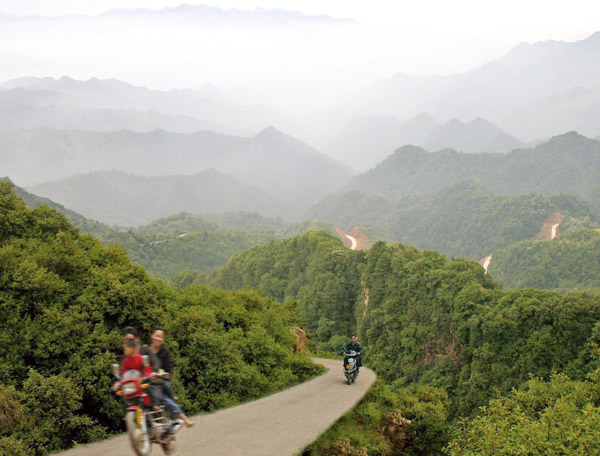Road to rural revival
Updated: 2012-03-19 14:08
By D J Clark (China Daily)
|
|||||||||||
 |
|
An asphalt road winds through mountains in Lushi county, Henan province, bringing vast improvements to residents' lives. Cheng Zhuanyi / for China Daily |
 |
|
Above: Old farmers congregate in the Jiangfushan village's square. Most young people work in cities. Below left: A clinic worker weighs traditional Chinese herbs at a township medical care center near Kengxi village, Zhejiang province. Below right: A new tap has been installed on a building in Shenxianzhai village, Guangdong province. Photos by D J Clark / China Daily |
 Journeys through remote settlements in Hebei, Zhejiang and Guangdong provinces reveal how transportation, healthcare and water safety changes are transforming the countryside. D J Clark reports in Guangdong province.
Journeys through remote settlements in Hebei, Zhejiang and Guangdong provinces reveal how transportation, healthcare and water safety changes are transforming the countryside. D J Clark reports in Guangdong province.
Driving through a steep mountain gorge and into Jiangfushan, my driver explained how the village was so hard to access that invading armies had never managed to penetrate its natural defenses.
I had traveled north and then west around the Bohai Sea from Liaoning province and into Hebei province for the second stage of my journey around rural China, investigating how 30 years of rural reforms had impacted the lives of villagers across the country.
 Greeting me at his farmhouse door was Di Bao, now in his 60s and nervous about being interviewed. I started by asking him how life in the village had changed.
Greeting me at his farmhouse door was Di Bao, now in his 60s and nervous about being interviewed. I started by asking him how life in the village had changed.
"Now is much better than 30 years ago. Science and technology has improved the agricultural output. This has been the main difference as a farmer," he told me, starting to settle his nerves as he sucked on a hand-rolled cigarette between questions.
"We used to grow 30 to 40 kg of rice per mu (15 mu equals 1 hectare). But now we grow around 500 kilos of rice per mu. We also used to have to carry water from the well, but now we have running water in every house, and we can use motorized vehicles for transport."
An asphalt road was built four years ago as part of a drive by the central government to connect villages across the country to the main highways.
In 2010, 95 percent of the task was complete, with country roads stretching 3.3 million km across China. By 2020, the government aims to connect the remaining 120,000 villages still without a paved road, mainly in the country's far west.
Following the interview, Di took me on a walk around the village, chatting with the people we met, all of whom seemed to concur that the road had brought many benefits.
"This road goes straight to Beijing," one villager claimed, reducing the trip to a one-hour bus ride rather than a day's journey, as it was before the road.
I asked Di why so many homes had piles of red bricks outside. He explained that young people from the village now commute to the city and have made money to pay for renovations. This answered a second question I was waiting to ask: Why did everyone we met appear to be older than 60?
"Now, basically the old men are farming in the village, and young people are going to the city to make money, just like a bird opens his wings and flies to the high sky," Di said, smiling.
As I was about to leave, I was distracted by the sound of sheep bells and left Di momentarily to investigate.
In a clearing I found Li Rang grazing his sheep. We struck up a conversation, and after several minutes, I asked him his thoughts about the new road and the benefits it brought him and his family. Unlike the other villagers I had met, he appeared aggravated by the question.
"This road is no help to farmers who don't have a car," he told me.
"After the road was built, no one has taken care of it. That means two cars can't pass, but nobody cares."
On my drive back to Beijing, I saw no evidence of Li's claims, though it was clear not everyone in the village approved the new link.
After a short period spent recuperating in Beijing, I was back out on the road, this time heading south through China's coastal provinces.
I was starting to enjoy the quietness of the countryside, and it was good to be out of the city again.
Kengxi village, a three-hour drive south of Zhejiang province's capital Hangzhou, was the perfect antidote to the streets of Beijing.
The odd sorghum plant rustled in the wind as I looked out over expanses of open paddy fields with mist-covered mountains behind.
I had an appointment at the village clinic - not for any ailment but to find out how rural healthcare had changed over the last three decades.
Sitting at a table opposite his brother, also a doctor, seeing patients one by one in an open consultation room, Dr Zhang Lifang asked me to take a seat and wait my turn.
Zhang came to the village to work in the clinic in 1987. Things changed little until five years ago, when the government implemented a new rural healthcare policy, greatly subsiding the doctors' treatments while adopting a strict medicine sales policy.
"When I came here in 1987, we had around 10 people coming to the village public health center every day. Nowadays, we get around 35 a day - it is up by about 200 percent," he told me, before I had a chance to ask my first question.
"We buy medicine and sell it to our patients at the same price, and the rural medical insurance will reimburse them 30 percent for Western medicine and 45 percent for Chinese medicine. Those with chronic illnesses like hypertension, diabetes, tumors and neurosis get free treatment at home."
In 2005, medical insurance was predominantly for city dwellers and covered only about a quarter of China's population. About 80 percent of medical facilities were based in urban areas.
To offset this imbalance, the government set out a five-year plan to rebuild the rural medical service system by supporting the construction of county-level hospitals, grassroots medical care institutions and village clinics.
They also set up a new affordable rural healthcare insurance, in all spending 1.13 trillion yuan ($179 billion) over the last three years, according to Vice-Minister of Finance Wang Jun.
By the end of last year, the new rural cooperative medical care system covered 830 million rural residents, raising China's total health insurance coverage to 95.5 percent of the population.
I left the clinic and spent the rest of the day walking around the village speaking to people about their health provision.
Everyone I met had joined the rural medical insurance plan, and many had already had need to use it.
One man had just returned from an appendicitis operation he claimed would have been difficult to afford without the insurance.
In the clinic, I learned the installation of safe drinking water taps in every home had been a major factor in improving villagers' health. The subject had been on my mind as I traveled down the coast south to Guangdong.
Unsafe drinking water is connected to 80 percent of all diseases and deaths in developing countries, water resource ministry experts say. In China, more than 50 diseases are the direct result of the water people drink.
A short drive from the orange markets of Sihui in Guangdong province, the village of Shenxianzhai was celebrating a new water treatment facility that has allowed every house in the village to have a tap delivering safe drinking water.
Before the installation of the facility, local residents had to walk 2 km to the nearest safe supply and carry the water back in buckets.
Seeing a pipe going into one house, I followed it in and met Huang Zhong, a local farmer who showed me two new taps in his home.
"We used to have to carry the water from the well to our home before, and the quality of the water was not very good," he said.
"Now that we have running water, the lives of the local residents are much easier and simpler."
Six years ago, China's ministry of water resources estimated 300 million rural residents did not have access to safe drinking water and set about creating a plan to put a tap in every home by 2020.
In the district of Zhaoqing, which Shenxianzhai is under, the local water authority was challenged to put a tap in the homes of 1 million residents who lacked access to safe water. They had just six years to complete the task - a challenge the water authority claims it met at the end of 2011.
"Before this project was completed, the people in this village used to get their water from underground. The water from underground is not safe, and many people became sick," Cheng Zhibin, vice-director of the Sihui county water bureau, later explained to me.
Cheng also admitted the groundwater was likely the cause of the village's high liver cancer rate.
"We carry out a lot of tests, using different measures to disinfect the water. After testing it and disinfecting it, we bring the safe water here to people's homes."
About a third of the 300 million people have been reached, and the job is expected to be completed by 2020.
For the residents of Shenxianzhai, drinking a glass of water has become a much less risky affair.
Today's Top News
Rescuers race against time for quake victims
Telecom workers restore links
Coal mine blast kills 18 in Jilin
Intl scholarship puts China on the map
More bird flu patients discharged
Gold loses sheen, but still a safe bet
US 'turns blind eye to human rights'
Telecom workers restore links
Hot Topics
Lunar probe , China growth forecasts, Emission rules get tougher, China seen through 'colored lens', International board,
Editor's Picks

|

|

|

|

|

|





